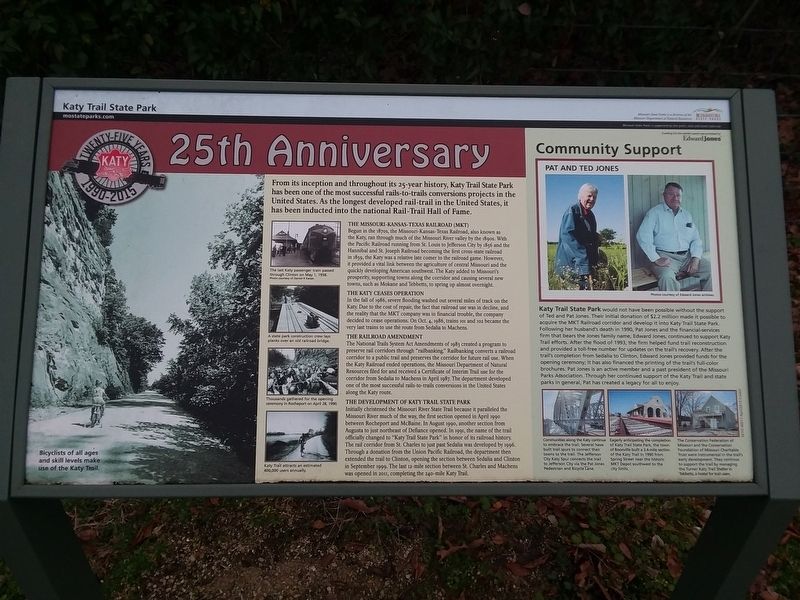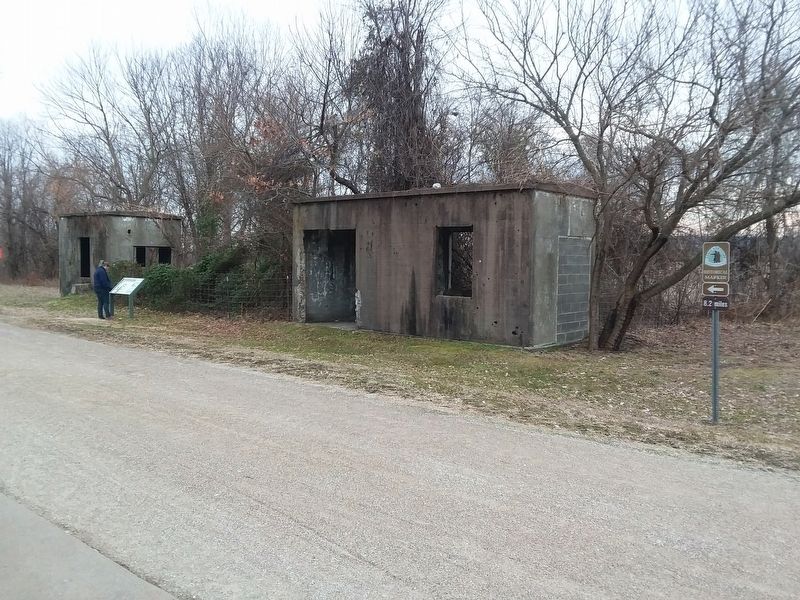25th Anniversary
Katy Trail State Park
From its inception and throughout its 25-year history, Katy Trail State Park has been one of the most successful rails-to-trails conversions projects in the United States. As the longest developed rail-trail in the United States, it has been inducted into the national Rail-Trail Hall of Fame.
The Missouri-Kansas-Texas Railroad (MKT)
Begun in the 1870s, the Missouri-Kansas-Texas Railroad, also known as
the Katy, ran through much of the Missouri River valley by the 1890s. With
the Pacific Railroad running from St. Louis to Jefferson City by 1856 and the
Hannibal and St. Joseph Railroad becoming the first cross-state railroad
in 1859, the Katy was a relative late comer to the railroad game. However,
it provided a vital link between the agriculture of central Missouri and the
quickly developing American southwest. The Katy added to Missouri's
prosperity, supporting towns along the corridor and causing several new
towns, such as Mokane and Tebbetts, to spring up almost overnight.
The Katy Ceases Operation
In the fall of 1986, severe flooding washed out several miles of track on the
Katy. Due to the cost of repair, the fact that railroad use was in decline, and
the reality that the MKT company was in financial trouble, the company
decided to cease operations.
The Railroad Amendment
The National Trails System Act Amendments of 1983 created a program to
preserve rail corridors through "railbanking.” Railbanking converts a railroad
corridor to a public trail and preserves the corridor for future rail use. When
the Katy Railroad ended operations, the Missouri Department of Natural
Resources filed for and received a Certificate of Interim Trail use for the
corridor from Sedalia to Machens in April 1987. The department developed
one of the most successful rails-to-trails conversions in the United States
along the Katy route.
The Development of Katy Trail State Park
Initially christened the Missouri River State Trail because it paralleled the
Missouri River much of the way, the first section opened in April 1990
between Rocheport and McBaine. In August 1990, another section from
Augusta to just northeast of Defiance opened. In 1991, the name of the trail
officially changed to "Katy Trail State Park” in honor of its railroad history.
The rail corridor from St. Charles to just past Sedalia was developed by 1996.
Through a donation from the Union Pacific Railroad, the department then
extended the trail to Clinton, opening the section between Sedalia and Clinton
in September 1999.
[Captions:]
The last Katy passenger train passed
through Clinton on May 1, 1958.
A state park construction crew lays planks over an old railroad bridge.
Thousands gathered for the opening ceremony in Rocheport on April 28, 1990.
Katy Trail attracts an estimated 400,000 users annually.
Community Support
Pat and Ted Jones
Katy Trail State Park would not have been possible without the support
of Ted and Pat Jones. Their initial donation of $2.2 million made it possible to
acquire the MKT Railroad corridor and develop it into Katy Trail State Park
Following her husband's death in 1990, Pat Jones and the financial-services
firm that bears the Jones family name, Edward Jones, continued to support Katy
Trail efforts. After the flood of 1993, the firm helped fund trail reconstruction
and provided a toll-free number for updates on the trail's recovery. After the
trail's completion from Sedalia to Clinton, Edward Jones provided funds for the
opening ceremony; it has also financed the printing of the trail's full-color
brochures. Pat Jones is an active member and a past president of the Missouri
Parks Association. Through her continued support of the Katy Trail
[Captions:]
Communities along the Katy continue
to embrace the trail. Several have
built trail spurs to connect their
towns to the trail. The Jefferson
City Katy Spur connects the trail
to Jefferson City via the Pat Jones
Pedestrian and Bicycle Lane.
Eagerly anticipating the completion of Katy Trail State Park, the town of Boonville built a 3.4-mile section of the Katy Trail in 1990 from Spring Street near the historic MKT Depot southwest to the city limits.
The Conservation Federation of
Missouri and the Conservation
Foundation of Missouri Charitable
Trust were instrumental in the trail's
early development. They continue
to support the trail by managing
the Turner Katy Trail Shelter in
Tebbetts, a hostel for trail users.
Erected by Missouri Department of Natural Resources.
Topics and series. This historical marker is listed in these topic lists: Parks & Recreational Areas • Railroads & Streetcars. In addition, it is included in the Katy Trail State Park series list. A significant historical month for this entry is April 1987.
Location. 38° 44.033′ N, 91° 26.65′ W. Marker is in McKittrick, Missouri, in Montgomery County. Marker is on Sterline Road, 0.1 miles west of Walnut Street, on the right when traveling south. Marker is in parking lot of the Katy Trail State Park, McKittrick Area. Touch for map. Marker is at or near this postal address: 500 Walnut St, Hermann MO 65041, United States of America. Touch for directions.
Other nearby markers. At least 8 other markers are within 2 miles of this marker, measured as the crow flies. McKittrick to Portland (a few steps from this marker); McKittrick to Treloar (a few steps from this marker); Capt. Steven Neil Bezold (about 300 feet away, measured in a direct line); Gasconade County Courthouse (approx. 1.9 miles away); Pioneer Trails Juncture (approx. 1.9 miles away); The Maria Waechter House (approx. 1.9 miles away); The Lewis and Clark Expedition Across Missouri (approx. 1.9 miles away); Hermann: Germania's Liberator (approx. 1.9 miles away). Touch for a list and map of all markers in McKittrick.
Credits. This page was last revised on December 10, 2020. It was originally submitted on December 10, 2020, by Craig Doda of Napoleon, Ohio. This page has been viewed 106 times since then and 8 times this year. Photos: 1, 2. submitted on December 10, 2020, by Craig Doda of Napoleon, Ohio. • Devry Becker Jones was the editor who published this page.

